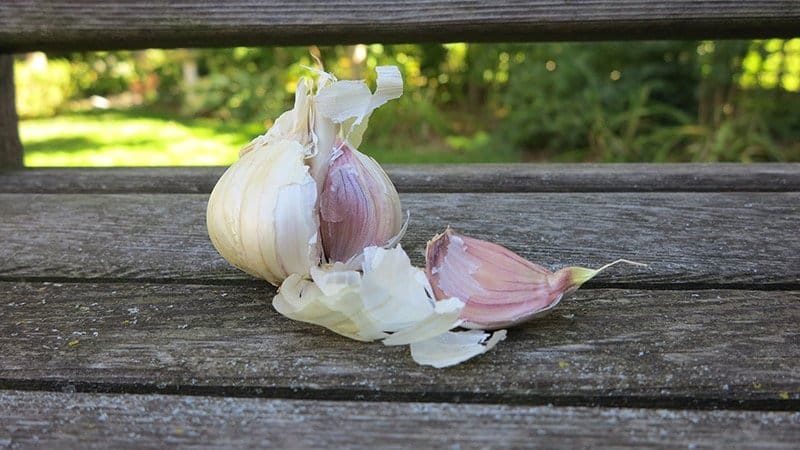
I try to plant some hard neck garlic (Allium sativum, Zone 3) every October. Like any other hardy bulbous plant (including spring tulips and other ornamental bulbs), garlic begins making roots in the fall, just as soon as it’s buried in soft, rich soil. In spring, it begins forming an underground head, and sends up green blades and a thick stem that will eventually carry flowers and seeds. But the energy already stored in the garlic clove planted in the fall has a lot to do with the size of the garlic to be harvested next July. A big garlic clove on planting day make big heads next summer.
The converse is true, too: Planting small cloves results in small garlic heads at harvest time. That’s why I try to purchase heads of garlic with husky cloves. Those fat cloves carry the most energy to feed the plant, and I also provide bloodmeal or a balanced granular fertilizer (such as 10-10-10) to add more nutrients. I set the individual cloves four inches (10 cm) deep in moist soil, spacing them about six inches (15 cm) apart, and cover the bed with a three-inch (8-cm) layer of leaves.
On the year’s I plant garlic, I save the fattest cloves to plant in autumn. But if I don’t have saved cloves to plant, I rely on seed catalogues or even garlic from the supermarket. When sourcing garlic from supermarkets, I always look for heads grown in North America. A better bet is to find garlic at a farmers’ market, because it will have been grown in the region and be adaptable to my garden climate.
Sourcing garlic from seed catalogues (damseeds.ca, veseys.com, halifaxseed.ca) is most satisfying, because I can usually purchase a named cultivar with a brief description of the bulb’s characteristics. It’s worthwhile to do some Internet research on named cultivars for additional information and reports from other growers. Garlic purchased from seed companies is sold by the pound, and I usually receive good-sized heads with large cloves.
A few named garlic cultivars that sound promising include ‘Music’, which produces five to seven large cloves per head and stores well. Pungent ‘Music’ is hot when eaten raw, but mellows sweetly when cooked. ‘Legacy’ makes a larger head with eight or nine large cloves, but the flavour mellows in storage. ‘Bogatyr’ produces heads with four to seven large cloves, and is strongly flavoured, with fiery hotness. ‘Siberian’ is another hot and spicy garlic (closely related to ‘Bogatyr’), with a strong flavour when raw, but creamy and mild when roasted (and it caramelizes nicely). ‘Siberian’ also grows milder in storage. These named garlics are all adapted to cold-climate growing, and will be hardy in the ground under a thick blanket of snow.
The garlic I’m still looking for is ‘Ontario Giant’, also known as ‘Puslinch’, which makes large heads with up to eight fat, juicy cloves. Researching garlic is a pleasant preoccupation at this time of year — I could spend hours doing this! I’m glad to have some interesting cultivars available for planting. Garlic is sometimes described as the taste that inspires passion, and I’m all for that!









Garlic lovers may find this article about Dundurn Castle interesting.
https://www.thespec.com/life/2019/09/12/kathy-renwald-bushels-bulbs-and-the-bounty-of-september.html
I have planted Music for the last 8 years and have been very happy with the resulting large heads without using any fertilizer. Have not started to use the scales to make a seasoning.
I just ordered Puslinch from [email protected] Hope that helps!
Last year I planted both Red Russian and Music. Leek moth attacked and ruined the Music while the Red Russian remained untouched.
Red Russian is a hot and juicy garlic and is quite hardy, also stores well.
Rather than the supermarket, look for garlic at local farmers markets. Supermarket garlic may be treated with chemicals to prevent spoilage or retard sprouting. May also be imported, usually from China. Farmers markets offer locally grown garlic. This is where I obtain my stock. If you are not fussy about knowing the variety, it is a good way to get started.
Growing garlic is one of my favorite gardening pastimes. Last year I obtained a wonderful hardneck variety called European Porcelain from growers near here in Pictou county. It gave the best results of any variety I have grown in recent years.
I also grew Music last year….it performed quite well and seems quite similar to the European Porcelain, although they are not reputed to be close relatives.
We also tried German White from Botanus, which does seem closely related to the European Porcelain.
I don’t know if you have read the wonderful book by Ted Jordan Meredith called “The Complete Book of Garlic,” but it is worth the time. He has a website and online catalogue.
http://garlicseed.blogspot.ca/
A few years ago we obtained a variety that originated in Ontario called Wyndvale Heights. Gardenimport was the distributor, but sadly it seems to be no longer available.
We are anticipating the fall planting. The site has a cover crop of buckwheat that will be dug in this week.